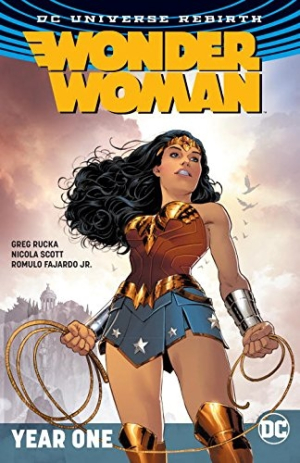Wonder Woman
Volume 2: Year One
Greg Rucka, Nicola Scott, and Romulo Fajardo Jr. lay out a thoroughly enjoyable origin story for one of DC’s most famous characters, in their exciting and endearing graphic novel Wonder Woman: Year One.
Wonder Woman, despite being perhaps the single most recognizable female superhero ever created, has always suffered from the lack of a definitive, memorable origin story. Where Batman had his parents’ murder in Crime Alley, and Superman was sent to Earth from a crumbling planet Krypton, many conflicting versions of Wonder Woman’s origin were created during the seventy-six years the character has been in print.
Wonder Woman: Year One collects issues 2, 4, 6, 8 ,10, 12, and 14 from the monthly DC Universe Rebirth series Wonder Woman, which alternated between a “present-day” story line (collected in Wonder Woman Vol. One: The Lies) and the new origin story.
Rucka’s script and Scott’s art shine in equal measure, introducing Diana as a young woman, chosen as her people’s champion to travel from her home island of Themyscira. Year One reintroduces longtime Wonder Woman characters like Steve Trevor and Etta Candy, but most notable is the appealing portrayal of Diana as she becomes Wonder Woman—a capable figure, yet somewhat innocent and idealistic in her understanding of the wider world.
Diana is visited by “the patrons”—“Gray-eyed Athena and proud Hera and cunning Artemis”—in their animal forms. These creatures are described as providing her “gifts”—her super powers. But unlike in earlier tales, Diana’s culture is no longer described as strictly the product of Greek myth; Barbara Ann Minerva, an archaeologist destined to become Cheetah, one of Wonder Woman’s greatest nemeses, says of the Amazon language, “It’s an amalgam dialect. Greco-Slavic, but there’s an Afro-Asiatic presence.” This slant opens new possibilities for an origin story set in the twenty-first century, allowing the believable use of characters from diverse backgrounds—Themyscira’s all-female population boasts a wide variety of hair and skin colors, more representative of modern-day readership.
A character who’s been around such a long time can be intimidating to new readers—the question of what to read first is common. Wonder Woman: Year One provides an answer: this.
Reviewed by
Peter Dabbene
Disclosure: This article is not an endorsement, but a review. The publisher of this book provided free copies of the book to have their book reviewed by a professional reviewer. No fee was paid by the publisher for this review. Foreword Reviews only recommends books that we love. Foreword Magazine, Inc. is disclosing this in accordance with the Federal Trade Commission’s 16 CFR, Part 255.

